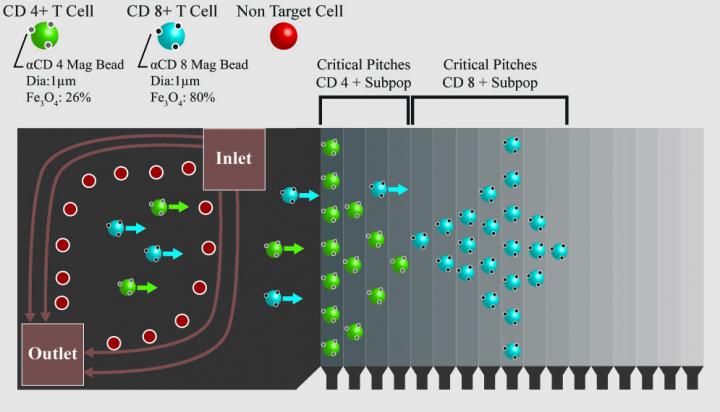Enabling technology in cell-based therapies: Scale-up, scale-out or program in-place

Technologies that are reducing costs and changing the ways in which researchers and clinicians process and use therapeutic cells are showcased in the August 2018 special issue of SLAS Technology. Credit: Coleman Murray, University of California, Los Angeles
Advances reported in this issue include methods of cell separation that utilize unique microscale forces for use with higher cell concentrations or larger sample volumes; techniques, device packages and footprints that utilize “smart” dynamic magnetic traps, microfluidic separators, and acoustic energy-based cell separation techniques provide new inline and closed-loop systems; and methods to better automate or package complex cell manipulations into closed bioreactor systems.
The arrival of FDA-approved chimeric antigen receptors (CAR) T-cell therapies and the expansion of T-cell and other cell-based therapies beyond oncology applications, have reinvigorated discussions around the ways in which researchers harvest, culture, process, or directly alter therapeutic cells.
However, the manufacturing process (i.e. selection of peripheral blood mononuclear cells from whole blood, activation of T cells, transduction with CAR viral vectors or transposons, and expansion in an appropriate bioreactor) for combination gene/cell therapies such as CAR T is complex, and there remain many opportunities to decrease costs and improve safety of these important new clinical tools.
###
The SLAS Technology special issue on Enabling Technology in Cell-Based Therapies: Scale-Up, Scale-Out or Program In-Place can be accessed at http://journals.
A PDF of this article is available to credentialed media outlets upon request. Contact nhallock@slas.org.
About our Society and Journals
SLAS (Society for Laboratory Automation and Screening) is an international community of nearly 20,000 professionals and students dedicated to life sciences discovery and technology. The SLAS mission is to bring together researchers in academia, industry and government to advance life sciences discovery and technology via education, knowledge exchange and global community building.
SLAS DISCOVERY: 2016 Impact Factor 2.444. Editor-in-Chief Robert M. Campbell, Ph.D., Eli Lilly and Company, Indianapolis, IN (USA). SLAS Discovery (Advancing Life Sciences R&D) was previously published (1996-2016) as the Journal of Biomolecular Screening (JBS).
SLAS TECHNOLOGY: 2016 Impact Factor 2.850. Editor-in-Chief Edward Kai-Hua Chow, Ph.D., National University of Singapore (Singapore). SLAS Technology (Translating Life Sciences Innovation) was previously published (1996-2016) as the Journal of Laboratory Automation (JALA).
Follow SLAS on Twitter at @SLAS_Org.
Follow SLAS on Facebook at SocietyforLaboratoryAutomationandScreening.
Follow SLAS on YouTube at SLASvideo.
Follow SLAS Americas on LinkedIn at Society for Laboratory Automation and Screening (SLAS Americas).
Follow SLAS Europe on LinkedIn at Society for Laboratory Automation and Screening Europe (SLAS Europe).
Media Contact
All latest news from the category: Health and Medicine
This subject area encompasses research and studies in the field of human medicine.
Among the wide-ranging list of topics covered here are anesthesiology, anatomy, surgery, human genetics, hygiene and environmental medicine, internal medicine, neurology, pharmacology, physiology, urology and dental medicine.
Newest articles

NASA: Mystery of life’s handedness deepens
The mystery of why life uses molecules with specific orientations has deepened with a NASA-funded discovery that RNA — a key molecule thought to have potentially held the instructions for…

What are the effects of historic lithium mining on water quality?
Study reveals low levels of common contaminants but high levels of other elements in waters associated with an abandoned lithium mine. Lithium ore and mining waste from a historic lithium…

Quantum-inspired design boosts efficiency of heat-to-electricity conversion
Rice engineers take unconventional route to improving thermophotovoltaic systems. Researchers at Rice University have found a new way to improve a key element of thermophotovoltaic (TPV) systems, which convert heat…



